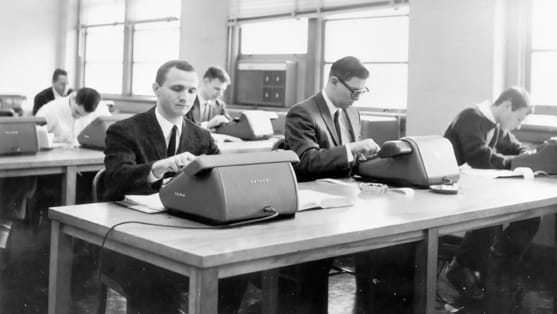Editor’s Note: Our regular “From The Vault” feature from our Spring issue generated enormous reader response. For good reason, too: We here at Wharton Magazine made a mistake. In the opening sentence of our short piece about Dietrich Hall, we wrote that the pictured students could be seen “typing away” on “clunky typewriters.” At least, we thought they were typewriters. But it turns out, they weren’t— and many of our readers wrote in to correct our mistake. We received far too many letters to include in this issue. But here are some of our favorites.
I read with great interest your short note about Dietrich Hall in the spring issue of Wharton Magazine.
You may be interested to learn that the “clunky typewriters” in the 1960 photo were not typewriters at all.
They were mechanical calculators, which were actually able (believe it or not) to multiply or divide large numbers in a fraction of a minute. They produced their results one digit at a time, but very quickly. This was obviously a great labor-saver compared with doing this type of calculation manually, which is why you see so many Wharton students (all male and mostly with jackets and ties, I noted) taking advantage of the availability of these state-of-the-art devices.
There were two such machines in the early 1950s—Friden (the ones pictured) and Marchant. My recollection is that the Marchants were “clunkier” than the Fridens; so perhaps by 1960 the Fridens were the only ones used.
I should add that Dietrich Hall was indeed a great improvement over the prior site for most Wharton classes, Logan Hall, though I don’t recall any air conditioner as is present in the 1960 photo. I fondly remember an 8 a.m. class in a cramped, non-air-conditioned attic classroom on the top floor of Logan in my pre-Dietrich freshman year.
-David Sachs, W’54
Before electronic calculators, before computers, before Excel spreadsheets, there was the Friden. The advent of the electronic calculator quickly obsoleted these heavy, large and somewhat confusing-to-operate machines, which were truly a work of art and science.
Using a system of gears, buttons and levers, the calculating machine could solve complex mathematical problems, in addition to the basic add, subtract, multiply and divide functions. While solving the problem, the machine would shake, rattle and clank while the long bar at the top would move from side to side. They were amazing machines, and worth the time to look up online.
At an accounting firm I worked at during my college years’ summers, we would see who could set up the problem that would take the longest to solve, just to see the machines dance and hear the rhythmic beat of the gears.
-Joel Kantor, W’66
I howled with laughter at the sight of the 1960 photograph of Dietrich Hall and [the sentence], “Don’t let those clunky typewriters fool you.” Those clunky calculators did fool you!
In addition, my fellow students never came to class so handsomely dressed and well groomed. Perhaps these students dressed for the photo op or were on their way to an interview? Anyone recognize themselves? And note the ashtray on the table!
Thank you for a lively and entertaining magazine.
-Brita Skarbrevik, W’58
Those contraptions pictured are (almost certainly) what were called accounting or bookkeeping machines—in effect, large electro-mechanical adding machines with rows and columns of mechanical digit keys like old-time cash registers.
I think they were mostly replaced by electronic adding machines by the early 70s, though in my early post-MBA career, in the late 70s and early 80s, I would sometimes stumble upon one at a vacant desk in my job travels. After plugging it in, for fun (obviously I am easily amused) I would enter something like 999,999,999 divided by 111 and then watch the machine mechanically whirr through the calculation, often taking as long as 30-45 seconds!
The carriage you see at the top of the machines in the photo would move during this process. Even then, I was amazed to realize that these accounting machines were once the cutting edge of our computational technology.
Thanks for sharing this.
-D. Craig Blizzard, WG’77
I believe you may have dated yourself in the Spring 2010 edition (as am I now!). On page 10, the “clunky typewriters” shown in “From The Vault” appear to be “clunky adding machines” (aka Friden calculators).
Notwithstanding this historical discrepancy, the Wharton Magazine in its revamped format is refreshing and a pleasure to read.
-Robert W. Swaney, W’63
Excuse me, but those so-called “typewriters” labeled in your photo are Rotary Calculators, precursors of the electronic version. The guy in the front of the photo is operating a Friden brand and the next man over is using a Marchant.
How do I know? My dad was a regional sales manager for Marchant for 20 or so years in Indianapolis.
-Jerrold Asher, WG’54
I was amused by the explanation under the picture taken in Dietrich Hall that the students were using “typewriters.”
As can be clearly seen, those are Friden Electro-Mechanical calculators, not typewriters. Almost no one owned a calculator at that time, and the room was available in Dietrich Hall to work on projects involving mathematical calculations.
Today I have a better calculator that I bought for a dollar at Wal-Mart.
-M. Bruce Miner, W’60


























